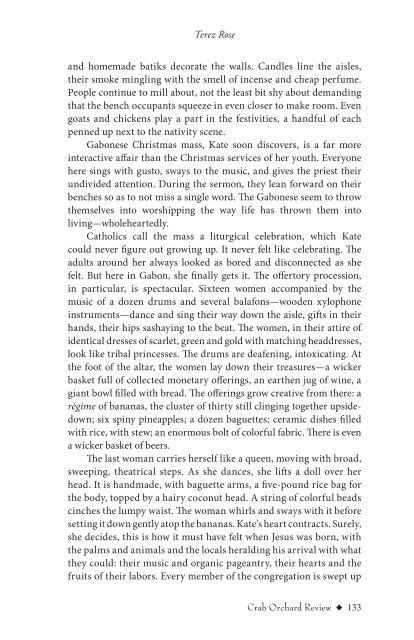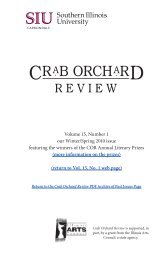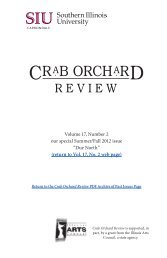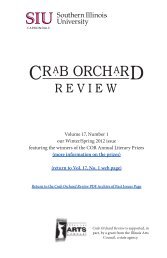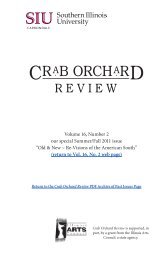Crab Orchard Review Vol. 12, No. 2, our
Crab Orchard Review Vol. 12, No. 2, our
Crab Orchard Review Vol. 12, No. 2, our
You also want an ePaper? Increase the reach of your titles
YUMPU automatically turns print PDFs into web optimized ePapers that Google loves.
Terez Rose<br />
and homemade batiks decorate the walls. Candles line the aisles,<br />
their smoke mingling with the smell of incense and cheap perfume.<br />
People continue to mill about, not the least bit shy about demanding<br />
that the bench occupants squeeze in even closer to make room. Even<br />
goats and chickens play a part in the festivities, a handful of each<br />
penned up next to the nativity scene.<br />
Gabonese Christmas mass, Kate soon discovers, is a far more<br />
interactive affair than the Christmas services of her youth. Everyone<br />
here sings with gusto, sways to the music, and gives the priest their<br />
undivided attention. During the sermon, they lean forward on their<br />
benches so as to not miss a single word. The Gabonese seem to throw<br />
themselves into worshipping the way life has thrown them into<br />
living—wholeheartedly.<br />
Catholics call the mass a liturgical celebration, which Kate<br />
could never figure out growing up. It never felt like celebrating. The<br />
adults around her always looked as bored and disconnected as she<br />
felt. But here in Gabon, she finally gets it. The offertory procession,<br />
in particular, is spectacular. Sixteen women accompanied by the<br />
music of a dozen drums and several balafons—wooden xylophone<br />
instruments—dance and sing their way down the aisle, gifts in their<br />
hands, their hips sashaying to the beat. The women, in their attire of<br />
identical dresses of scarlet, green and gold with matching headdresses,<br />
look like tribal princesses. The drums are deafening, intoxicating. At<br />
the foot of the altar, the women lay down their treasures—a wicker<br />
basket full of collected monetary offerings, an earthen jug of wine, a<br />
giant bowl filled with bread. The offerings grow creative from there: a<br />
régime of bananas, the cluster of thirty still clinging together upsidedown;<br />
six spiny pineapples; a dozen baguettes; ceramic dishes filled<br />
with rice, with stew; an enormous bolt of colorful fabric. There is even<br />
a wicker basket of beers.<br />
The last woman carries herself like a queen, moving with broad,<br />
sweeping, theatrical steps. As she dances, she lifts a doll over her<br />
head. It is handmade, with baguette arms, a five-pound rice bag for<br />
the body, topped by a hairy coconut head. A string of colorful beads<br />
cinches the lumpy waist. The woman whirls and sways with it before<br />
setting it down gently atop the bananas. Kate’s heart contracts. Surely,<br />
she decides, this is how it must have felt when Jesus was born, with<br />
the palms and animals and the locals heralding his arrival with what<br />
they could: their music and organic pageantry, their hearts and the<br />
fruits of their labors. Every member of the congregation is swept up<br />
<strong>Crab</strong> <strong>Orchard</strong> <strong>Review</strong> ◆ 133


